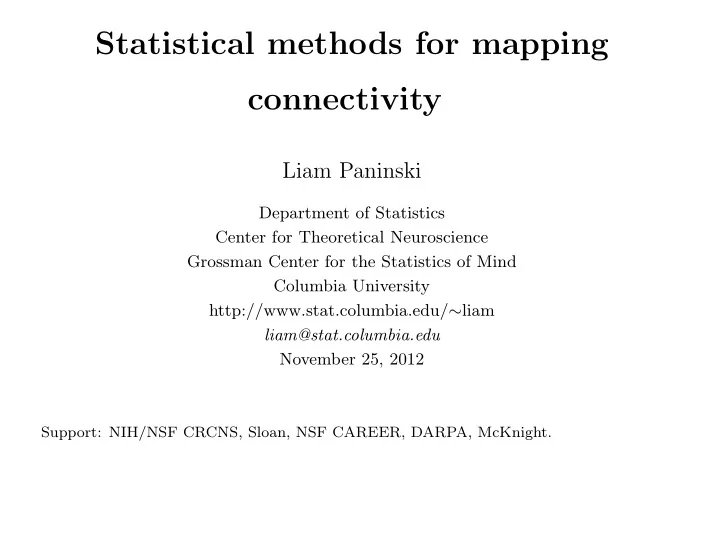

Statistical methods for mapping connectivity Liam Paninski Department of Statistics Center for Theoretical Neuroscience Grossman Center for the Statistics of Mind Columbia University http://www.stat.columbia.edu/ ∼ liam liam@stat.columbia.edu November 25, 2012 Support: NIH/NSF CRCNS, Sloan, NSF CAREER, DARPA, McKnight.
Circuit inference from large-scale Ca 2+ imaging w/ R. Yuste, K. Shepard, Y. Ahmadian, J. Vogelstein, Y. Mishchenko, B. Watson, A. Murphy
Challenge: slow, noisy calcium data First-order model: C t + dt = C t − dtC t /τ + r t ; r t > 0; y t = C t + ǫ t — τ ≈ 100 ms; nonnegative deconvolution problem. Interior-point approach leads to O ( T ) solution (Vogelstein et al., 2009; Vogelstein et al., 2010; Mishchenko et al., 2010).
Spatiotemporal Bayesian spike estimation (Loading Tim-data0b2.mp4) Rank-penalized convex optimization with nonnegativity constraints. E. Pnevmatikakis and T. Machado, ongoing
Simulated circuit inference Sparse Prior Sparse Prior 1 Positive weights 0.6 Negative weights Inferred connection weights 0.4 Zero weights 0.8 0.2 0 Histogram 0.6 −0.2 −0.4 0.4 −0.6 −0.8 0.2 −1 0 −2 −1.5 −1 −0.5 0 0.5 1 1.5 −8 −6 −4 −2 0 2 4 Actual connection weights Connection weights Good news: connections are inferred well in biologically-plausible simulations (Mishchencko et al., 2009), if most neurons in circuit are observable. Fast enough to estimate connectivity in real time (T. Machado). Preliminary experimental results are encouraging (correct identification checked w/ intracellular recordings). Open challenge: method is non-robust when smaller fractions of the network are observable. Currently pursuing latent-variable approach (Vidne et al., 2009).
Bayesian signal processing on dendritic trees Variable of interest, V t , evolves according to a noisy differential equation (e.g., cable equation): dV/dt = f ( V ) + ǫ t . Make noisy observations: y ( t ) = g ( V t ) + η t . We want to infer E ( V t | Y ): optimal estimate given observations. We also want errorbars: quantify how much we actually know about V t . If f ( . ) and g ( . ) are linear, and ǫ t and η t are Gaussian, then solution is classical: Kalman filter. (Many generalizations available; e.g., (Huys and Paninski, 2009).) Even Kalman case is challenging, since d = dim( � V ) is very large: computation of Kalman filter requires O ( d 3 ) computation per timestep (Paninski, 2010): methods for Kalman filtering in just O ( d ) time: take advantage of sparse tree structure. Generalizable to many other state-space models (Pnevmatikakis and Paninski, 2011), and to spatiotemporal calcium recordings (Pnevmatikakis et al., 2011).
Example: inferring voltage from subsampled observations (Loading low-rank-speckle.mp4)
Applications • Optimal experimental design: which parts of the neuron should we image? Submodular optimization (Huggins and Paninski, 2011) • Estimation of biophysical parameters (e.g., membrane channel densities, axial resistance, etc.): reduces to a simple nonnegative regression problem once V ( x, t ) is known (Huys et al., 2006) • Detecting location and weights of synaptic input
Application: synaptic locations/weights
Application: synaptic locations/weights
Application: synaptic locations/weights Including known terms: d� V /dt = A� V ( t ) + W � U ( t ) + � ǫ ( t ); U ( t ) are known presynaptic spike times, and we want to detect which compartments are connected (i.e., infer the weight matrix W ). Loglikelihood is quadratic; W is a sparse vector. Adapt standard LARS-like (homotopy) approach (Pakman et al., 2012). Total computation time: O ( dTk ); d = # compartments, T = # timesteps, k = # nonzero weights.
Example: inferring dendritic synaptic maps 700 timesteps observed; 40 compartments (of > 2000) observed per timestep Note: random access scanning essential here: results are poor if we observe the same compartments at each timestep. “Compressed sensing” observations improve results further. Can also use Bayesian methods to estimate errorbars.
References Huggins, J. and Paninski, L. (2011). Optimal experimental design for sampling voltage on dendritic trees. J. Comput. Neuro. , In press. Huys, Q., Ahrens, M., and Paninski, L. (2006). Efficient estimation of detailed single-neuron models. Journal of Neurophysiology , 96:872–890. Huys, Q. and Paninski, L. (2009). Model-based smoothing of, and parameter estimation from, noisy biophysical recordings. PLOS Computational Biology , 5:e1000379. Mishchenko, Y., Vogelstein, J., and Paninski, L. (2010). A Bayesian approach for inferring neuronal connectivity from calcium fluorescent imaging data. Annals of Applied Statistics , In press. Paninski, L. (2010). Fast Kalman filtering on quasilinear dendritic trees. Journal of Computational Neuroscience , 28:211–28. Pnevmatikakis, E., Kelleher, K., Chen, R., Josic, K., Saggau, P., and Paninski, L. (2011). Fast nonnegative spatiotemporal calcium smoothing in dendritic trees. COSYNE . Pnevmatikakis, E. and Paninski, L. (2011). Fast interior-point inference in high-dimensional sparse, penalized state-space models. Submitted . Vidne, M., Kulkarni, J., Ahmadian, Y., Pillow, J., Shlens, J., Chichilnisky, E., Simoncelli, E., and Paninski, L. (2009). Inferring functional connectivity in an ensemble of retinal ganglion cells sharing a common input. COSYNE . Vogelstein, J., Packer, A., Machado, T., Sippy, T., Babadi, B., Yuste, R., and Paninski, L. (2010). Fast non-negative deconvolution for spike train inference from population calcium imaging. J. Neurophys. , In press. Vogelstein, J., Watson, B., Packer, A., Jedynak, B., Yuste, R., and Paninski, L. (2009). Model-based optimal inference of spike times and calcium dynamics given noisy and intermittent calcium-fluorescence imaging. Biophysical Journal , 97:636–655.
Recommend
More recommend